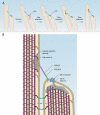Review series: The cell biology of hearing
- PMID: 20624897
- PMCID: PMC2911669
- DOI: 10.1083/jcb.201001138
Review series: The cell biology of hearing
Abstract
Mammals have an astonishing ability to sense and discriminate sounds of different frequencies and intensities. Fundamental for this process are mechanosensory hair cells in the inner ear that convert sound-induced vibrations into electrical signals. The study of genes that are linked to deafness has provided insights into the cell biological mechanisms that control hair cell development and their function as mechanosensors.
Figures




References
-
- Adato A., Lefèvre G., Delprat B., Michel V., Michalski N., Chardenoux S., Weil D., El-Amraoui A., Petit C. 2005a. Usherin, the defective protein in Usher syndrome type IIA, is likely to be a component of interstereocilia ankle links in the inner ear sensory cells. Hum. Mol. Genet. 14:3921–3932 10.1093/hmg/ddi416 - DOI - PubMed
-
- Ahmed Z.M., Goodyear R., Riazuddin S., Lagziel A., Legan P.K., Behra M., Burgess S.M., Lilley K.S., Wilcox E.R., Riazuddin S., et al. 2006. The tip-link antigen, a protein associated with the transduction complex of sensory hair cells, is protocadherin-15. J. Neurosci. 26:7022–7034 10.1523/JNEUROSCI.1163-06.2006 - DOI - PMC - PubMed
-
- Alagramam K.N., Murcia C.L., Kwon H.Y., Pawlowski K.S., Wright C.G., Woychik R.P. 2001. The mouse Ames waltzer hearing-loss mutant is caused by mutation of Pcdh15, a novel protocadherin gene. Nat. Genet. 27:99–102 - PubMed
Publication types
MeSH terms
Grants and funding
LinkOut - more resources
Full Text Sources
Medical

